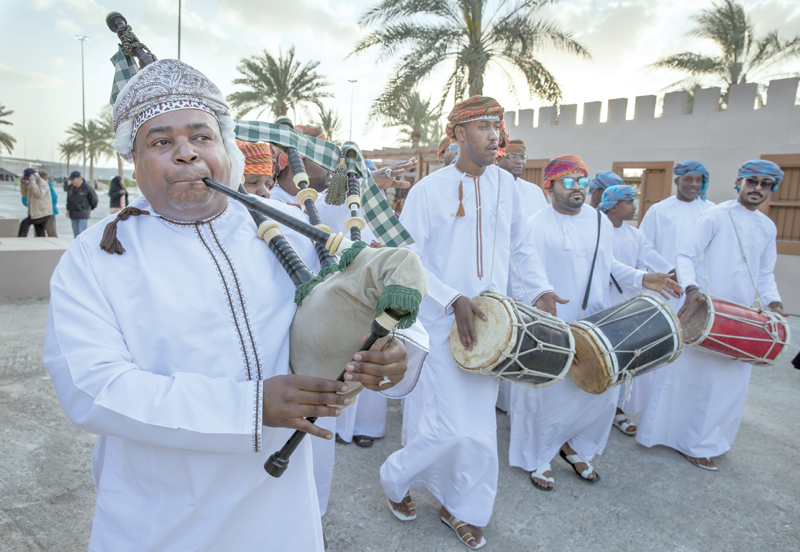

Greek dance historian Prof Dr Alkis Raftis presently heads the International Dance Council (CID) at UNESCO, Paris. Considered a leading authority on dance in Greece, he is well-known for his books on dance history.
CID is the official umbrella organisation for all forms of dance in all countries of the world. With the formation of the Muscat section of CID in April 2017, the President has chalked out concrete plans for its future.

Prof Raftis expects the Muscat Section to act as a pioneer within the area and incite other cities in the Gulf to come out with their own section. “Each section deals with wider issues beyond the scope of each dance school or dance company, such as organising festivals, lectures, exhibitions, workshops, ceremonies, trips abroad for their members, inviting teachers from other countries, celebrating Dance Day, presenting dance programmes on TV and others.”
As President of the Athens-based Dora Stratou Dance Theatre and Company since 1987, Prof Raftis looks forward to include traditional forms of Oman dance.
He says: “All forms of dance should be included in a section. Traditional Omani dance is practically unknown outside the Sultanate and deserves to be presented to a wider global audience. Dance is the first glimpse one gets of another culture while other subjects follow.”
Oman’s performance at the Athens Congress in July 2017 came in for high praise. “It was for the first time the Sultanate performed at a World Congress so everyone was curious to watch their performance and meet the performers.”

‘The Muscat section is young and dynamic,’ points out Prof Raftis and hails the initiative of Premila Ramesh, a reputed dancer in Muscat, who has quickly gone through the requirements managing to bring on board other school directors.
As Director, Orbit Training Centre of Performing, Premila, managed to include over 60 members representing various dance forms.
CID embraces all dance forms and plans are afoot to provide them international recognition.
Recognising the work of Premila, Prof Raftis has encouraged her to take CID closer to as many dance professionals as possible in the Sultanate. Unesco recognises three of the traditional dances of Oman and would like to see many more of the rich cultural diversity from Oman, he points out.
Three traditional Omani dance forms namely Alazi, Alayalah and Taghrodah, are in the UNESCO Intangible Cultural Heritage list.
Members of the Muscat Section can enjoy outreach to international audience and arenas for performances; increased visibility for their dance form; possibilities to participate in World Dance Congresses held world over; internationally certified ‘Level Certificates’ for their learning of any dance forms with certain conditions.
Armenian dance researcher, teacher and choreographer Anahit Saribekyan (Anah) from CID, formally opened the Muscat section in April last during the International Dance Day celebrations. Anah represents the Vanadzor section of CID, which is the third-largest city of Armenia.
The 50th World Congress of Dance held in Athens, in July last saw the Sultanate putting up an impressive performance. There are 12 dance professionals under Premila, Director, Nrityanjali, led Oman’s delegation at the World Congress. Anahit performed an abstract monumental dance at Dora Stratou Theatre, under the Vanadzor Section, and Anah Sari International Arts Academy from Athens.
Researching the history of dance in the Eastern Mediterranean before 1900, Prof Alkis became a dance historian as dance was his passion along with dance anthropology. As an engineer he was trained to find concrete solutions to problems, which helps him a lot.
He says: “As a sociologist I try to get an overall view of dance in a country, and essential in placing dance in the wider context of society. I used to be a manager in multinational corporations, then got my doctor’s degree in management and taught at universities. Management knowhow is most important in running a large organisation like CID, without which I would not have been successful.”
Over the years he learned a lot about various forms of dance. “The President of CID must know well about each form of dance to understand the concern of dance teachers and must speak their language. Most dance professionals know only their own form of dance but a dance administrator must have a very wide spectrum.”
Prof Raftis says the biggest concern is International Certification. “Most schools around the world do not know about it, they teach dance for years without offering a single document to their students. We in CID spend a lot of time spreading information, trying to persuade dance school directors to do what schools of all matters do: offer a valid document to students.”
With regard to Oman, he says that they have now the first batch of certified students. Hopefully other dance schools will follow until certification becomes the norm in the same manner as all schooling does from primary school through university.
Elected by the General Assembly and re-elected for 4 years, the experience and guidance from Prof Raftis should be of valuable help to the Muscat chapter in the years ahead. The next International Congress on Dance Research will be held later this month in Saint-Petersburg, Russia, followed by the World Congress on Dance Research at Athens in July and Mumbai, India, in December.
Oman Observer is now on the WhatsApp channel. Click here



